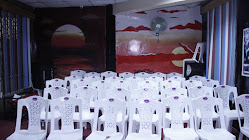This is why al-Shabab won’t be going away anytime soon
Thursday July 6, 2017
Students in Nairobi protest an attack by gunmen at the Garissa University College in April 2015. Al-Shabab asserted responsibility for the attack. (Thomas Mukoya/Reuters)
On June 14, the
terrorist group al-Shabab — an al-Qaeda affiliate — attacked a pizza restaurant
in Mogadishu, the capital of Somalia, by detonating a car bomb and sending in
assailants.
More than 30 people were killed. Earlier in June, al-Shabab
overran a military base in the semiautonomous area of Puntland, killing dozens.
The group recently surpassed Boko Haram as the deadliest terrorist organization
in Africa.
But it’s not the violence that’s attracting followers. My recent field research in Kenya and Somalia, the two East African countries where al-Shabab is most active, suggests that al-Shabab is thriving because it’s still offering a comparatively attractive alternative to the Somali government. It capitalizes on grievances, keeps areas secure and settles disputes, with relatively little corruption. That’s especially attractive in undeveloped or remote areas that the fledgling government has neglected.
As a result, al-Shabab is becoming a shadow government, positioning itself as Somalia’s champion of disenfranchised and marginalized clans.
But it’s not the violence that’s attracting followers. My recent field research in Kenya and Somalia, the two East African countries where al-Shabab is most active, suggests that al-Shabab is thriving because it’s still offering a comparatively attractive alternative to the Somali government. It capitalizes on grievances, keeps areas secure and settles disputes, with relatively little corruption. That’s especially attractive in undeveloped or remote areas that the fledgling government has neglected.
As a result, al-Shabab is becoming a shadow government, positioning itself as Somalia’s champion of disenfranchised and marginalized clans.
The United States has been increasing its military presence and
expanding its rules of engagement in Somalia to counter al-Shabab. On June 11,
the United States conducted its first strike under these new rules, destroying
an al-Shabab training and command center, and then conducted a second strike on
July 2, with still a third one on July 4. In March, at the urging of the Defense
Department, the Trump administration designated Somalia as an “area of active
hostilities,” which allows the United States to conduct offensive strikes that
do not require interagency vetting.
How strong is al-Shabab?
To some, al-Shabab looks weakened. It no longer controls major cities or ports. Nor does it have the capacity to militarily recapture them. With those losses went ways to get resources. In addition, international action has reduced al-Shabab’s profit from commodities such as charcoal. Once flush with fighters from all over the world, al-Shabab now recruits foreign fighters primarily from the region; foreign fighters no longer figure in the group’s senior ranks. Al-Shabab has not launched a major terrorist attack outside Somalia since 2015.
How strong is al-Shabab?
To some, al-Shabab looks weakened. It no longer controls major cities or ports. Nor does it have the capacity to militarily recapture them. With those losses went ways to get resources. In addition, international action has reduced al-Shabab’s profit from commodities such as charcoal. Once flush with fighters from all over the world, al-Shabab now recruits foreign fighters primarily from the region; foreign fighters no longer figure in the group’s senior ranks. Al-Shabab has not launched a major terrorist attack outside Somalia since 2015.
Though looking to relinquish responsibility to Somali security
forces, African Union forces (known as the African Union Mission in Somalia, or
AMISOM) are there to support Somalia’s new government, which won a national
election in February.
But al-Shabab has shown an impressive ability to adapt — and is positioned to not only survive, but to thrive. It has been territorially constrained by AMISOM — but it has overrun AMISOM forward operating bases (FOB), killing and injuring scores of troops and seizing arms, military vehicles and heavy weaponry. The group’s forces are highly decentralized, but it can mass various units to launch an attack.
Further, al-Shabab’s intelligence apparatus, the Amniyat, has been disrupting life in the Somali capital with bombings, assassinations and targeted attacks.
How common is such violence? So common that one person I interviewed in Mogadishu shrugged off a bombing earlier that day as “Somali music.”
What about the group’s presence in Kenya? It’s true that al-Shabab has not carried out an attack in Kenya as large as its attacks on the Westgate mall or Garissa University since 2015. But in the past month, the group has launched IED attacks in Kenya’s northeast and coastal areas. It’s trying to stoke insecurity and widen communal fissures just weeks before the Kenyan elections, a time when tensions are high and there are heightened concerns about potential election-related violence.
Al-Shabab functions as an effective local government
But al-Shabab has shown an impressive ability to adapt — and is positioned to not only survive, but to thrive. It has been territorially constrained by AMISOM — but it has overrun AMISOM forward operating bases (FOB), killing and injuring scores of troops and seizing arms, military vehicles and heavy weaponry. The group’s forces are highly decentralized, but it can mass various units to launch an attack.
Further, al-Shabab’s intelligence apparatus, the Amniyat, has been disrupting life in the Somali capital with bombings, assassinations and targeted attacks.
How common is such violence? So common that one person I interviewed in Mogadishu shrugged off a bombing earlier that day as “Somali music.”
What about the group’s presence in Kenya? It’s true that al-Shabab has not carried out an attack in Kenya as large as its attacks on the Westgate mall or Garissa University since 2015. But in the past month, the group has launched IED attacks in Kenya’s northeast and coastal areas. It’s trying to stoke insecurity and widen communal fissures just weeks before the Kenyan elections, a time when tensions are high and there are heightened concerns about potential election-related violence.
Al-Shabab functions as an effective local government
Al-Shabab has deftly
managed clan dynamics and provided basic services in ways that have brought it
political power and influence throughout southern Somalia, especially the rural
areas, where residents are wary of the still-fragile government. That’s what I
found as I conducted interviews in Kenya and Somalia in January and in May and
June this year.
Security. Al-Shabab offers services that the government still does not, particularly to populations distrustful or excluded from the still-fragile political process. Al-Shabab offers a modicum of security in areas under its influence. It operates courts, including mobile courts, to punish crime and resolve disputes.
Security. Al-Shabab offers services that the government still does not, particularly to populations distrustful or excluded from the still-fragile political process. Al-Shabab offers a modicum of security in areas under its influence. It operates courts, including mobile courts, to punish crime and resolve disputes.
That’s especially important in an area rife with local conflicts,
especially land disputes, and few effective ways to settle them, except
violence. While media reports focus on al-Shabab’s harsh sharia punishments,
some Somalis seek out al-Shabab courts, knowing that they will deliver a
relatively thorough verdict and will enforce resolution.
Taxation. Al-Shabab has a remarkably effective taxation system that few dare to defy, even those living, as one person I interviewed put it, “a stone’s throw from an AMISOM FOB.” That brings in a steady stream of revenue. What’s more, al-Shabab is relatively uncorrupt and efficient. You can see that clearly on the roads that it controls, where it operates checkpoints that require set payments, offer a receipt to passengers, and keep the roads relatively safe.
That contrasts sharply with how others, including government forces, manage roads, which are rife with predation and repeated extortion, which has both safety and economic repercussions — as I heard repeatedly from citizens, businesspeople and aid workers alike.
Decentralized and embedded. Al-Shabab positions itself as a defender of disenfranchised and marginalized clans, expertly manipulating and capitalizing on local and clan grievances to gain support — including gathering the support of anti-government leaders and militias. This has caused the group to become more decentralized, integrating into local communities and permeating Somali society in a way that will make it increasingly difficult to distinguish civilians from combatants.
Taxation. Al-Shabab has a remarkably effective taxation system that few dare to defy, even those living, as one person I interviewed put it, “a stone’s throw from an AMISOM FOB.” That brings in a steady stream of revenue. What’s more, al-Shabab is relatively uncorrupt and efficient. You can see that clearly on the roads that it controls, where it operates checkpoints that require set payments, offer a receipt to passengers, and keep the roads relatively safe.
That contrasts sharply with how others, including government forces, manage roads, which are rife with predation and repeated extortion, which has both safety and economic repercussions — as I heard repeatedly from citizens, businesspeople and aid workers alike.
Decentralized and embedded. Al-Shabab positions itself as a defender of disenfranchised and marginalized clans, expertly manipulating and capitalizing on local and clan grievances to gain support — including gathering the support of anti-government leaders and militias. This has caused the group to become more decentralized, integrating into local communities and permeating Somali society in a way that will make it increasingly difficult to distinguish civilians from combatants.
This dispersed but relatively well-organized structure includes
compartmentalized military, terrorism and intelligence apparatuses. Most of
those captured can provide little intelligence beyond their narrow range of
responsibilities. And everyone is aware that al-Shabab ruthlessly targets
defectors and kills suspected spies.
Al-Shabab finds ways to exploit the vacuum left by the state,
tapping into a deep reservoir of grievances. It has both conventional military
strength and terrorist abilities as well as political and ideological influence
that goes beyond its territorial holdings. It has become the main alternative
to the government. It will not be defeated by military means alone, and the
fitful progress by the Somali government may come too little, too late.
Subscribe to:
Post Comments
(
Atom
)


















No comments :
Post a Comment